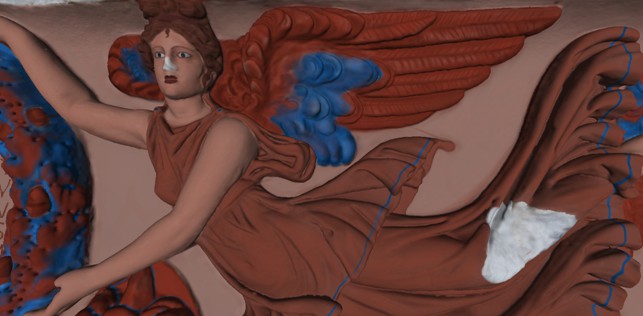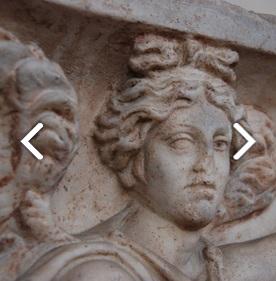3D Models for the study, reconstruction and visualization of the colour
Digital reconstruction of the ancient polychromy is a relatively recent phenomenon in the history of archaeological and architectural heritage documentation. It has emerged as a result of new interest of the experimental archaeology and of the technological development of Computer Graphic tools. Therefore, this research aims to identify both the pigments and the colour application techniques used, and the exploration of potential emerging technologies in the reconstruction and visualization of the ancient colour.
Case study
The test activity has been carried out on the polychrome sarcophagus dedicated to Ulpia Domnina patroness (Museo Nazionale Romano, inv. no. 125891). It is a mass-production sarcophagus with Victories holding a shield and funerary Cupids that was chosen mainly because of the fair state of preservation of its original polychromy, which could have shed light on the colouring techniques used.
Methodology and testing activity
The digitization of the sarcophagus was performed first by producing a geometrical 3D model (acquired with a laser triangulation scanner) and then by acquiring the colour attribute by means of high-resolution and calibrated photographs (using a DLSR camera).
The scientific reconstruction of the original polychromy and the realistic rendering of the Roman sarcophagus, was obtained with the use of some open source tools. This was possible after the knowledge of the reference values for the original colours. In particular, MeshLab tool was used to support the polychrome reconstruction stage, and Blender (or, rather, a combination of MeshLab and Blender) was used to achieve a more sophisticated visual presentation of the current and reconstruction ancient colour.
A central role has been given to the improve the archaeological knowledge and rendering of the different and overlapped layers of paint. The sarcophagus proved to be an interesting case study because we discovered that it was coloured at two different periods in antiquity. That is a very important for the archaeological studies because it is the first documented case of reuse in antiquity by scientific analyses.
3D viewer
At the moment more details are available in publications. Clicking on the image you can visualize, in interactive way, the geometrical 3D model and it is possible switch from current colour for original colouring proposal (middle 3rd cent. AD).
 3D viewer
3D viewer
Credits
Manager:
Eliana Siotto (VC Lab ISTI-CNR, Pisa, IT)
Roberto Scopigno (VC Lab ISTI-CNR, Pisa, IT)
Corrado Gratziu (University of Pisa, IT)
Rosanna Friggeri (Soprintendenza Speciale per i Beni Archeologici di Roma - Director of the
Museo Nazionale Romano - Terme di Diocleziano, Rome, IT)
3D digitalization:
Eliana Siotto and
Matteo Dellepiane (VC Lab ISTI-CNR, Pisa, IT)
3D data processing:
Eliana Siotto,
Matteo Dellepiane and
Gianpaolo Palma (VC Lab ISTI-CNR, Pisa, IT)
3D polychrome reconstruction:
Eliana Siotto (VC Lab ISTI-CNR, Pisa, IT)
3D rendering:
Marco Callieri (VC Lab ISTI-CNR, Pisa, IT)
Photography:
Eliana Siotto (VC Lab ISTI-CNR, Pisa, IT)
Archaeological and archival researches:
Eliana Siotto (VC Lab ISTI-CNR, Pisa, IT)
Optical petrographic microscopy analysis:
Corrado Gratziu and Alessandra Moscato (University of Pisa, IT)
Raman spectroscopy analysis:
Stefano Legnaioli and
Giulia Lorenzetti (ICCOM-CNR, Pisa, IT)
Lucia Burgio (
Victoria & Albert Museum, London, UK)
Colorimetric analysis and multispectral visible and infrared imaging:
Vincenzo Palleschi (ICCOM-CNR, Pisa, IT)
VIL analysis:
Eliana Siotto,
Gianpaolo Palma and
Paolo Pingi (VC Lab ISTI-CNR, Pisa, IT)
Samples activity:
Giovanna Bandini (Soprintendenza Speciale per i Beni Archeologici di Roma - Manager of Conservation Lab of the
Museo Nazionale Romano - Terme di Diocleziano, Rome, IT)
3DHOP viewer:
Marco Potenziani,
Marco Callieri,
Federico Ponchio and
Eliana Siotto (VC Lab ISTI-CNR, Pisa, IT)
Acknowledgements:
Paolo Liverani (University of Florence, IT)
Jan Stubbe Østergaard (Ny Carlsberg Glyptotek, Copenhagen, DK)
Fulvia Donati (University of Pisa, IT)
Antonella Bertagnini (National Institute of Geophysics and Volcanology, Pisa, IT)
The
ArTeSalVa project that has partial financed this work (FSE POR 2007/2013)


